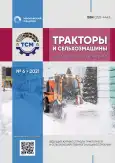Восстановление и легирование рабочих органов землеройных машин
- Авторы: Казанников О.В.1, Попов Е.В.1
-
Учреждения:
- Тихоокеанский Государственный университет
- Выпуск: Том 88, № 6 (2021)
- Страницы: 82-89
- Раздел: Качество, надёжность
- URL: https://journal-vniispk.ru/0321-4443/article/view/95644
- DOI: https://doi.org/10.17816/0321-4443-2021-6-82-89
- ID: 95644
Цитировать
Полный текст
Аннотация
При эксплуатации строительно-дорожных и землеройных машин наибольшему изнашиванию подвергаются их рабочие органы, в особенности коронки рыхлителей, ножи отвалов, зубья ковшей экскаваторов. Предельное состояние деталей характеризуется потерей массы изношенных элементов рабочих органов, имеющих непосредственный контакт с грунтом на 25–35 %. Выбракованные во время ремонта детали направляется на утилизацию или восстановление. Срок службы некоторых, наиболее нагруженных деталей при работе с тяжелыми грунтами составляет несколько часов. Известен факт, что потребность в коронках для землеройной техники у предприятий, задействованных на дорожно-строительных и карьерных работах в Дальневосточном регионе, измеряется десятками тысяч штук в год. Пополнение запасов быстро изнашиваемых деталей заставляет реализовывать сложные логистические схемы из-за отдаленности объектов от центров производства деталей, и всегда сопровождается значительными затратами. Поэтому проблема восстановления и упрочнения изношенных коронок рыхлителей и зубьев ковшей экскаваторов является весьма актуальной. Данную проблему различные производственные и научные организации решают уже давно, причем достаточно высокие результаты в этом направлении были получены после ряда разработок в институте электросварки имени Е.О. Патона в направлении способа электрошлаковой наплавки (ЭШН). На основе этого способа были созданы различные технологические процессы восстановления массивных деталей. Использование ЭШН позволяет не только восстанавливать детали со значительным износом, но и получать соответствующие конструкторским требованиям или улучшенные функциональные свойства, которые при восстановлении рабочих органов строительных и дорожных машин обеспечат повышение их стойкости. В данной работе рассматривается возможность восстановления изношенных коронок рабочих органов землеройных машин методом ЭШН с применением в качестве легирующих добавок рудных концентратов, добываемых на Дальнем Востоке.
Полный текст
Открыть статью на сайте журналаОб авторах
Олег Вячеславович Казанников
Тихоокеанский Государственный университет
Email: oleg97k@mail.ru
к.т.н.
Россия, ХабаровскЕвгений Васильевич Попов
Тихоокеанский Государственный университет
Автор, ответственный за переписку.
Email: 001698@pnu.edu.ru
Россия, Хабаровск
Список литературы
- Хрущов М.М, Бабичев М.А. Абразивное изнашивание. М.: Наука, 1970. 252 с.
- Виноградов В.Н., Сорокин Г.М., Колокольников М.Г. Абразивное изнашивание. М.: Машиностроение, 1990. 224 с.
- Крагельский И.В. Трение и износ. М.: Машиностроение, 1968. 480 с.
- Тененбаум М.М. Сопротивление абразивному изнашиванию. М.: Машиностроение, 1976. 271 с.
- Тененбаум М.М. Износостойкость конструкционных материалов и деталей машин при абразивном изнашивании. М.: Машиностроение, 1966. 331 с.
- Петров И.В., Смирнов С.И. и др. Износ и повышение долговечности зубьев ковшей экскаваторов // Строительство в районах Восточной Сибири и Крайнего Севера. Красноярск: Краснояр. промстройниипроект. Сб. № 13. 1966. С. 113−127.
- Львов П.Н. Основы абразивной износостойкости деталей строительных машин. М.: Стройиздат, 1970.
- Кащеев Р.А., Чудак С.И. Классификация основных факторов, определяющие абразивность и изнашивающую способность грунтов. Технология процессов разработки месторождений твердых полезных искрпаемых. Алма-Ата: КазПИ, 1982. С. 94−98.
- Половинко В.А., Федулов А.И. Повышение износостойкости зубьев экскаваторов. Новосибирск: ИГД СО АН СССР, 1999.
- Ветров Ю.А. Резание грунтов землеройными машинами. М.: Машиностроение. 1976. 360 с
- Тылкин М.А., Суслов А.А. Износостойкость материалов при отрицательных температурах // Строительство в районах Восточной Сибири и Крайнего Севера. Красноярск: Краснояр. промстройниипроект. Сб. № 30. 1974. С. 78−81.
- Петров И.В. Повышение надежности и долговечности рабочих органов строительных машин. М., 1977. 43 с.
- Лившиц Л.С., Гринберг Н.А., Куркумели Э.Г. Основы легирования наплавленного металла. М.: Машиностроение. 1969. 188 с.
- Износостойкая наплавка деталей землеройных машин // Строительное, дорожное и коммунальное машиностроение. М., 1981. № 3. 44 с.
- Бабенко Э.Г., Верхотуров А.Д. Разработка новых сварочных материалов на основе минерального сырья Дальневосточного региона: научная монография. Хабаровск: Издательство ДВГУПС; Владивосток: ДВО РАН, 2000. 144 с.
Дополнительные файлы













